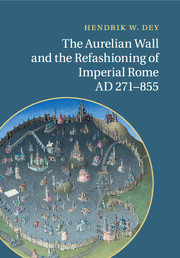Book contents
- Frontmatter
- Contents
- List of abbreviations
- List of figures
- Acknowledgements
- Introduction
- 1 Toward an architectural history of the Aurelian Wall, from its beginnings through the ninth century
- 2 Planning, building, rebuilding, and maintenance: the logistical dynamics of a (nearly) interminable project
- 3 Motives, meaning, and context: the Aurelian Wall and the late Roman state
- 4 The city, the suburbs, and the Wall: the rise of a topographical institution
- 5 Sacred geography, interrupted
- 6 The Wall and the “Republic of St. Peter”
- Conclusion
- Appendices
- Appendix A Numerical data
- Appendix B The fourth century revisited: the problem of Maxentius
- Appendix C The post-Honorian additions to the Porta Appia and other fifth- and sixth-century construction
- Appendix D The Aurelian Wall and the refashioning of the western tip of the Campus Martius
- Appendix E The Pons Agrippae and the Pons Aureli: a tale of two bridges
- Bibliography
- Index
Appendix E - The Pons Agrippae and the Pons Aureli: a tale of two bridges
Published online by Cambridge University Press: 19 May 2011
- Frontmatter
- Contents
- List of abbreviations
- List of figures
- Acknowledgements
- Introduction
- 1 Toward an architectural history of the Aurelian Wall, from its beginnings through the ninth century
- 2 Planning, building, rebuilding, and maintenance: the logistical dynamics of a (nearly) interminable project
- 3 Motives, meaning, and context: the Aurelian Wall and the late Roman state
- 4 The city, the suburbs, and the Wall: the rise of a topographical institution
- 5 Sacred geography, interrupted
- 6 The Wall and the “Republic of St. Peter”
- Conclusion
- Appendices
- Appendix A Numerical data
- Appendix B The fourth century revisited: the problem of Maxentius
- Appendix C The post-Honorian additions to the Porta Appia and other fifth- and sixth-century construction
- Appendix D The Aurelian Wall and the refashioning of the western tip of the Campus Martius
- Appendix E The Pons Agrippae and the Pons Aureli: a tale of two bridges
- Bibliography
- Index
Summary
The piers 140 meters upstream of the modern Ponte Sisto came to light in 1887, when work on the banks of the Tiber and the exceptionally low level of the river at the time combined to reveal a series of pilings spanning the river at this point. The results were published by L. Borsari, first in preliminary form in the Notizie degli Scavi (1887, 322–7), and then in the Bullettino Comunale of the following year (1888, 92–8). Borsari had no doubt that these were the foundations of a bridge, which he associated with the Pons Agrippae, the existence of which was demonstrated for the first time in an inscription coincidentally discovered not far upstream in the same year, recording restorations to the Tiber banks under Claudius that extended a Tr[ig]ar[io] ad pontem Agrippae (CIL 6, 31545). Since no remains of the superstructure turned up on the riverbed, he conjectured that the original Pons Agrippae was spoliated to build the Pons Aureli/Antonini just downriver, remnants of which had been found ten years earlier. As the twin names of the latter inevitably recalled the person of Marcus Aurelius Severus Antoninus Bassianus Caracalla, and as the Severan emperors occupied themselves with the banks of the Tiber, and had property in Trastevere, Borsari speculated that the newer bridge was built in the Severan period (BullCom 1888, 95–7).
- Type
- Chapter
- Information
- Publisher: Cambridge University PressPrint publication year: 2011



